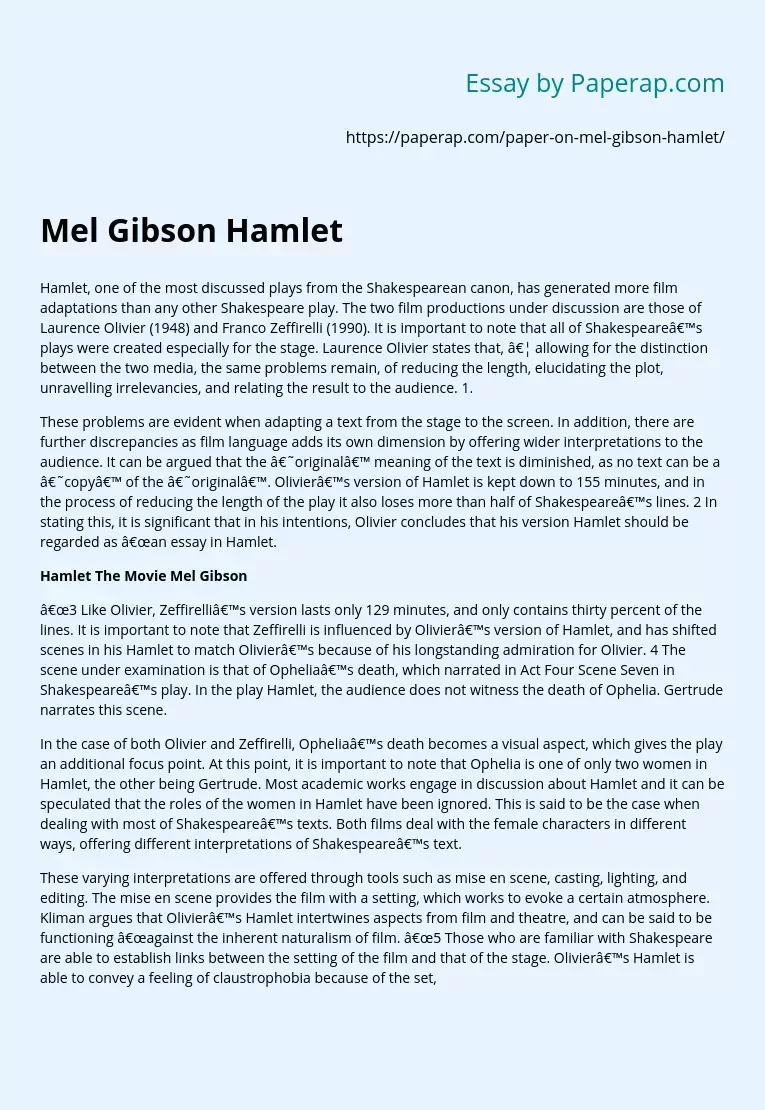Mel Gibson Hamlet
Hamlet, one of the most discussed plays from the Shakespearean canon, has generated more film adaptations than any other Shakespeare play. The two film productions under discussion are those of Laurence Olivier (1948) and Franco Zeffirelli (1990). It is important to note that all of Shakespeare’s plays were created especially for the stage. Laurence Olivier states that, … allowing for the distinction between the two media, the same problems remain, of reducing the length, elucidating the plot, unravelling irrelevancies, and relating the result to the audience.
1.
These problems are evident when adapting a text from the stage to the screen. In addition, there are further discrepancies as film language adds its own dimension by offering wider interpretations to the audience. It can be argued that the ‘original’ meaning of the text is diminished, as no text can be a ‘copy’ of the ‘original’. Olivier’s version of Hamlet is kept down to 155 minutes, and in the process of reducing the length of the play it also loses more than half of Shakespeare’s lines.
2 In stating this, it is significant that in his intentions, Olivier concludes that his version Hamlet should be regarded as “an essay in Hamlet.
Hamlet The Movie Mel Gibson
“3 Like Olivier, Zeffirelli’s version lasts only 129 minutes, and only contains thirty percent of the lines. It is important to note that Zeffirelli is influenced by Olivier’s version of Hamlet, and has shifted scenes in his Hamlet to match Olivier’s because of his longstanding admiration for Olivier. 4 The scene under examination is that of Ophelia’s death, which narrated in Act Four Scene Seven in Shakespeare’s play.
In the play Hamlet, the audience does not witness the death of Ophelia. Gertrude narrates this scene.
In the case of both Olivier and Zeffirelli, Ophelia’s death becomes a visual aspect, which gives the play an additional focus point. At this point, it is important to note that Ophelia is one of only two women in Hamlet, the other being Gertrude. Most academic works engage in discussion about Hamlet and it can be speculated that the roles of the women in Hamlet have been ignored. This is said to be the case when dealing with most of Shakespeare’s texts. Both films deal with the female characters in different ways, offering different interpretations of Shakespeare’s text.
These varying interpretations are offered through tools such as mise en scene, casting, lighting, and editing. The mise en scene provides the film with a setting, which works to evoke a certain atmosphere. Kliman argues that Olivier’s Hamlet intertwines aspects from film and theatre, and can be said to be functioning “against the inherent naturalism of film. “5 Those who are familiar with Shakespeare are able to establish links between the setting of the film and that of the stage. Olivier’s Hamlet is able to convey a feeling of claustrophobia because of the set, which is “dominated by staircases and closed spaces.
“6 This indication enables the audience to assume that this film is not a comedy, but a tragedy. These closed, claustrophobic spaces are emphasised as being inside the castle, portraying that there is more tragedy to the film than what meets the eye. The visual language in Zeffirelli’s film version works to highlight dramatic themes and issues. He uses cinematic techniques such as colour tinting, which plays with the idea of emphasising one of two colours, so that a particular mood can be associated to the scene in question. 7 This may involve a scene, which is picturised in either the interior or the exterior of the castle.
Particular areas are normally associated with certain characters. This is true when considering Ophelia, who is often seen in pastoral settings rather than within the uncomfortable setting of the castle. The casting of both films poses questions about Hamlet and the representation of the characters. When Olivier played the role of Hamlet, he was forty years old. Eileen Herlie, who plays Gertrude, was twenty-seven years old but looks a lot older. Jean Simmons, who was only sixteen years old, plays the character of Ophelia. Cartmell (1997) observes that she is “more like Hamlet’s daughter than his future wife.
Mel Gibson Hamlet. (2019, Dec 05). Retrieved from https://paperap.com/paper-on-mel-gibson-hamlet/

